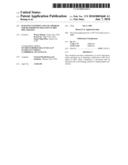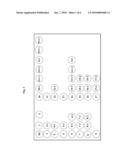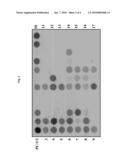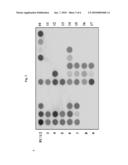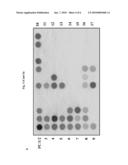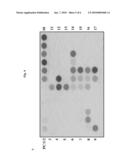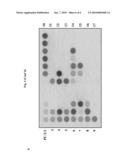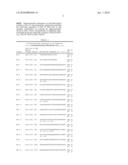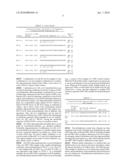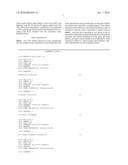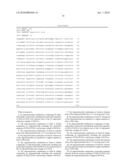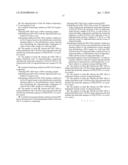Patent application title: Oligonucleotides and Use Thereof for Determining Deletion in HBV Pre-S Region
Inventors:
Wenya Huang (Tainan City, TW)
Ih-Jen Su (Taipei City, TW)
Fang-Ching Shen (Tainan City, TW)
Assignees:
NATIONAL HEALTH RESEARCH INSTITUTES
IPC8 Class: AC12Q170FI
USPC Class:
435 5
Class name: Chemistry: molecular biology and microbiology measuring or testing process involving enzymes or micro-organisms; composition or test strip therefore; processes of forming such composition or test strip involving virus or bacteriophage
Publication date: 2010-01-07
Patent application number: 20100003668
Claims:
1. An oligonucleotide combination, comprising 29 oligonucleotides,
respectively including the nucleotide sequences of SEQ ID NOs:2-30,
wherein each of the 29 oligonucleotides has a length of 20-50 nt.
2. The oligonucleotide combination of claim 1, further comprising an oligonucleotide including the nucleotide sequence of SEQ ID NO:1 and having a length of 20-50 nt.
3. The oligonucleotide combination of claim 2, wherein each of the oligonucleotides has a 5-17-nt-long poly(T) tail.
4. The oligonucleotide combination of claim 3, wherein all of the oligonucleotides are attached to a support member to form a DNA chip.
5. The oligonucleotide combination of claim 1, further comprising 14 oligonucleotides, respectively including the nucleotide sequences of SEQ ID NOs:31-44, wherein each of the 14 oligonucleotides has a length of 27-50 nt.
6. The oligonucleotide combination of claim 5, further comprising an oligonucleotide including the nucleotide sequence of SEQ ID NO:1 and having a length of 20-50 nt.
7. The oligonucleotide combination of claim 6, wherein each of the oligonucleotides has a 5-17-nt-long poly(T) tail.
8. The oligonucleotide combination of claim 7, wherein all of the oligonucleotides are attached to a support member to form a DNA chip.
9. An oligonucleotide combination, comprising 14 oligonucleotides, respectively including the nucleotide sequences of SEQ ID NOs:31-44, wherein each of the 14 oligonucleotides has a length of 27-50 nt.
10. The oligonucleotide combination of claim 9, further comprising an oligonucleotide including the nucleotide sequence of SEQ ID NO:1 and having a length of 20-50 nt.
11. The oligonucleotide combination of claim 10, wherein each of the oligonucleotides has a 5-17-nt-long poly(T) tail.
12. The oligonucleotide combination of claim 11, wherein all of the oligonucleotides are attached to a support member to form a DNA chip.
13. An oligonucleotide, comprising a nucleotide sequence selected from the group consisting of SEQ ID NOs:1-44, wherein the oligonucleotide has a length of 20-50 nt.
14. The oligonucleotide of claim 13, further comprising a 5-17-nt-long poly(T) tail.
15. A method of detecting a deletion in HBV Pre-S region, comprisingobtaining HBV DNA from a HBV-containing sample,hybridizing the HBV DNA with the oligonucleotide combination of claim 1, anddetermining whether the HBV DNA includes a deletion in its Pre-S region based on the hybridization results thus obtained relative to the hybridization results obtained from hybridizing the oligonucleotide combination of claim 1 with a DNA sample of a wild type HBV.
16. The method of claim 15, wherein the HBV DNA is further hybridized with a 20-50-nt-long oligonucleotide that includes the nucleotide sequence of SEQ ID NO:1 as a positive control.
17. The method of claim 16, wherein the HBV DNA is further hybridized with 14 oligonucleotides, respectively including the nucleotide sequences of SEQ ID NOs:31-44, wherein each of the 14 oligonucleotides has a length of 27-50 nt.
18. A method of detecting a deletion in HBV Pre-S2 region, comprisingobtaining HBV DNA from a HBV-containing sample,hybridizing the HBV DNA with the oligonucleotide combination of claim 9, anddetermining whether the HBV DNA includes a deletion in its Pre-S2 region based on the hybridization results thus obtained relative to the hybridization results obtained from hybridizing the oligonucleotide combination of claim 9 with a DNA sample of a wild type HBV.
19. The method of claim 18, wherein the HBV DNA is further hybridized with a 20-50-nt-long oligonucleotide that includes the nucleotide sequence of SEQ ID NO:1 as a positive control.
20. A method of assessing whether a patient carrying HBV has an increased risk of developing hepatocellular carcinoma (HCC) or cirrhosis, comprising:obtaining HBV DNA from a patient carrying HBV;hybridizing the HBV DNA with at least 29 oligonucleotides, respectively including the nucleotide sequences of SEQ ID NOs:2-30, and each of the 29 oligonucleotides having a length of 20-50 nt; or with at least 14 oligonucleotides, respectively including the nucleotide sequences of SEQ ID NOs:31-44, and each of the 14 oligonucleotides having a length of 27-50 nt; or with both the at least 29 oligonucleotides and the at least 14 oligonucleotides;determining whether the HBV DNA includes a deletion in its Pre-S region based on the hybridization results thus obtained relative to the hybridization results obtained from hybridizing a DNA sample of a wild type HBV with the at least 29 oligonucleotides, with the at least 14 oligonucleotides, or with both the at least 29 oligonucleotides and the at least 14 oligonucleotides; andassessing the patient's risk of developing HCC or cirrhosis, wherein a deletion in the Pre-S region indicates that the patient has an increased risk of developing HCC or cirrhosis relative to a patient carrying wild-type HBV.
21. The method of claim 20, wherein the HBV DNA is further hybridized with a 20-50-nt-long oligonucleotide that includes the nucleotide sequence of SEQ ID NO:1 as a positive control.
22. The method of claim 20, wherein the HBV DNA is hybridized with the at least 29 oligonucleotides.
23. The method of claim 22, wherein the HBV DNA is further hybridized with a 20-50-nt-long oligonucleotide that includes the nucleotide sequence of SEQ ID NO:1 as a positive control.
24. The method of claim 20, wherein the HBV DNA is hybridized with the at least 14 oligonucleotides.
25. The method of claim 24, wherein the HBV DNA is further hybridized with a 20-50-nt-long oligonucleotide that includes the nucleotide sequence of SEQ ID NO:1 as a positive control.
Description:
RELATED APPLICATION
[0001]This application claims priority to U.S. Provisional Application No. 61/077,522, filed on Jul. 2, 2008, the content of which is hereby incorporated by reference in its entirety.
BACKGROUND OF THE INVENTION
[0002]Hepatitis B virus (HBV) is a small, enveloped DNA virus that causes both acute and chronic liver diseases. Chronic HBV infection, a serious health problem in many Asian countries, often results in cirrhosis and hepatocellular carcinoma (HCC).
[0003]Deletion mutations in the Pre-S region of the HBV genome are found to be associated with an increased risk of cirrhosis and HCC. See Chen et al., Gastroenterology 133:1466-1474 (2007) and Ito et al., J. Gastroenterol. 42:837-844 (2007). It has been suggested that such deletions help HBV escape from host immune surveillance and enhance its transforming capacity. See Wang et al., Hepatology, 41:761-770 (2005).
[0004]Thus, there is a need to develop a rapid and accurate method for detecting deletions in the HBV Pre-S region, thereby assessing a HBV carrier's risk of developing cirrhosis/HCC.
SUMMARY OF THE INVENTION
[0005]The present invention is based on the discovery of a number of novel oligonucleotides for detecting deletion mutations in the Pre-S region of the HBV genome.
[0006]Accordingly, one aspect of this invention features an isolated oligonucleotide having a nucleotide sequence selected from SEQ ID NOs:1-44. The oligonucleotide can have a length of 20-50 nt (i.e., any number between 20 and 50). In one example, the oligonucleotide includes a poly(T) tail of 5-17 nucleotides (8 nt, 10 nt, or 15 nt). The term "isolated oligonucleotide" used herein refers to an oligonucleotide substantially free from naturally associated molecules, i.e., the naturally associated molecules constituting at most 20% by dry weight of a preparation containing the oligonucleotide. Purity can be measured by any appropriate method, e.g., column chromatography, polyacrylamide gel electrophoresis, and HPLC.
[0007]Another aspect of the invention relates to an oligonucleotide combination, i.e., combination (A), combination (B), or combination (C).
[0008]Oligonucleotide combination (A) contains at least 29 of the above-described oligonucleotides. Each of the 29 oligonucleotides includes a nucleotide sequence selected from SEQ ID NOs:2-30, any two of them including two different nucleotide sequences also selected from SEQ ID NOs:2-30. Preferably, this combination further contains an oligonucleotide that includes the nucleotide sequence of SEQ ID NO:1.
[0009]Oligonucleotide combination (B) contains at least 14 of the above-described oligonucleotides. Each of the 14 oligonucleotides includes a nucleotide sequence selected from SEQ ID NOs:31-44, any two of them including two different nucleotide sequences also selected from SEQ ID NOs:31-44. This combination can contain an additional oligonucleotide that includes the nucleotide sequence of SEQ ID NO:1.
[0010]Oligonucleotide combinations (A) and (B) can be merged to form oligonucleotide combination (C).
[0011]The oligonucleotides contained in combinations (A), (B), or (C) can be attached to a suitable support member to form a DNA chip.
[0012]Also within the scope of this invention is a method of using oligonucleotide combination (A), (B), or (C) for detecting a deletion(s) in the HBV Pre-S region, which includes subregions Pre-S1 and Pre-S2. Results thus obtained can be used to assess a HBV carrier's risk of developing cirrhosis or HCC. Namely, a patient who carries HBV with a deletion(s) in either the Pre-S1 or Pre-S2 region has an increased risk of developing cirrhosis or HCC relative to a HBV positive patient who carries wild-type HBV.
[0013]In one example, a test HBV DNA, obtained from a HBV-containing sample (e.g., cultured cells infected with HBV or a biosample of a HBV carrier), is hybridized with oligonucleotide combination (A) and the results thus obtained are compared with the results obtained from hybridizing the same oligonucleotide combination with wild-type HBV DNA to determine whether the test HBV DNA contains a deletion(s) in its Pre-S1 region.
[0014]In another example, a test HBV DNA, as described above, is hybridized with oligonucleotide combination (B) and the results thus obtained are compared with the results obtained from hybridizing the same oligonucleotide combination with wild-type HBV DNA to determine whether the test HBV DNA contains a deletion(s) in its Pre-S2 region.
[0015]In yet another example, a test HBV DNA is hybridized with oligonucleotide combination (C) and the results thus obtained are compared with the results obtained from hybridizing the same oligonucleotide combination with wild-type HBV DNA to determine whether the test HBV DNA contains a deletion(s) in its Pre-S region, including both Pre-S1 and Pre-S2 regions.
[0016]Combinations (A), (B), and (C) can also be used in the manufacture of kits for detecting a deletion(s) in the Pre-S region of HBV and for assessing a HBV-carrier's risk of developing cirrhosis and HCC.
[0017]The details of one or more embodiments of the invention are set forth in the description below. Other features or advantages of the present invention will be apparent from the following drawings and detailed description of an example, and also from the appended claims.
BRIEF DESCRIPTION OF THE DRAWINGS
[0018]The drawings are first described.
[0019]FIG. 1 is a map of a DNA chip, indicating positions of the oligonucleotides immobilized on it. PC: positive control oligonucleotide (SEQ ID NO:1; see Table 3 below). The nucleotide sequences of the other oligonucleotides are listed in Tables 1 and 2 below.
[0020]FIG. 2 is a photograph showing microarray results obtained from hybridizing wild-type HBV DNA with a DNA chip. The oligonucleotides contained in the DNA chip and their positions thereon are shown in the map of FIG. 1.
[0021]FIG. 3 is a photograph showing microarray results obtained from hybridizing HBV DNA bearing deletions in either the Pre-S1 or Pre-S2 region with the DNA chip described above. A: microarray results using HBV DNA bearing deletions in the Pre-S1 region. B: microarray results using HBV DNA bearing deletions in the Pre-S2 region.
[0022]FIG. 4 is a photograph showing microarray results obtained from hybridizing DNA samples prepared from two HBV positive patients with the DNA chip described above. A: microarray results obtained from Patient 1. B: microarray results obtained from Patient 2.
DETAILED DESCRIPTION OF THE INVENTION
[0023]Disclosed herein are a number of oligosaccharide combinations for detecting a deletion(s) in the Pre-S region of HBV DNA.
[0024]The HBV Pre-S region, located at nt 2854 to 154 in the HBV genome, includes two subregions, Pre-S1 (nt 2854 to 3210) and Pre-S2 (nt 3211 to 154). See Animal Virus Genetics, pg 57-70; Academic Press, New York (1980). The length of the Pre-S region in various genotypes of wild-type HBV remains the same, even though polymorphisms have been identified at many nucleotide positions in this region. An exemplary nucleotide sequence of the wild-type HBV Pre-S region is shown below:
TABLE-US-00001 Nucleotide Sequence of Wild-Type HBV DNA Pre-S Region (SEQ ID NO:48) atgggaggtt ggtcatcaaa acctcgcaaa ggcatgggga cgaatctttc 50 R1 R2 tgttcccaat cctctgggat tctttcccga tcatcagttg gaccctgcat 100 R3 R4 tcggagccaa ctcaaacaat ccagattggg acttcaaccc gtcaaggac 150 R5 R6 gactggccag cagccaacca agtaggagtg ggagcattcg ggccaaggct 200 R7 cacccctcca cacggcggta ttttggggtg gagccctcag gctcagggca 250 R8 R9 tattgaccac agtgtcaaca attcctcctc ctgcctccac caatcggcag 300 R10 R11 tcaggaaggc agcctactcc catctctcca cctctaagag acagtcatcc 350 R12 tcaggccatg cagtggaatt ccactgcctt ccaccaaact ctgcaggatc 400 R13 R14 ccagagtcag gggtctgtat cttcctgctg gtggctccag ttcaggaaca 450 R15 R16 gtaaaccctg ctccgaatat tgcctctcac atctcgtcaa tctccgcgag 500 R17 gactggggac cctgtgacga acatggagaa catcacatca ggattcctag 550 gacccctgct cgtgttacag gcggggtttt tcttgttgac aagaatcctc 600 acaataccgc agagtctaga ctcgtggtgg acttctctca attttctagg 650 gggatctccc gtgtgtcttg gccaaaattc gcagtcccca acctccaatc 700 actcaccaac ctcctgtcct ccaatttgtc ctggttatcg ctggatgtgt 750 ctgcggcgtt ttatcatatt cctcttcatc ctgctgctat gcctcatctt 800 cttattggtt cttctggatt atcaaggtat gttgcccgtt tgtcctctaa 850 ttccaggatc aacaacaacc agtacgggac catgcaaaac ctgcacgact 900 cctgctcaag gcaactctat gtttccctca tgttgctgta caaaacctac 950 ggatggaaat tgcacctgta ttcccatccc atcgtcctgg gctttcgcaa 1000 aatacctatg ggagtgggcc tcagtccgtt tctcttggct cagtttacta 1050 gtgccatttg ttcagtggtt cgtagggctt tcccccactg tttggctttc 1100 agctatatgg atgatgtggt attgggggcc aagtctgtac agcatcgtga 1150 gtccctttat accgctgtta ccaattttct tttgtctctg ggtatacatt 1200 taa
[0025]Oligonucleotide combination (A) described herein contains at least 29 oligonucleotides respectively including the nucleotide sequences of SEQ ID NOs:2-30. In one example, combination (A) contains the oligonucleotides shown in Table 1 below, and preferably, an additional oligonucleotide having the nucleotide sequence of SEQ ID NO:1 (e.g., WH-PC listed in Table 3 below).
TABLE-US-00002 TABLE 1 Oligonucleotides Contained in An Exemplary Oligonucleotide Combination (A) Position in HBV genome SEQ ID Oligos (Target Region) Nucleotide Sequence (5' → 3'') NO WH-1 2854-2873 (R1) TTTGATGACCAACCTCCCAT SEQ ID NO: 2 WH-2 2874-2893 (R2) TCCCCATGCCTTTGCGAGGT SEQ ID NO: 3 WH-3 2894-2923 (R3) ATCCCAGAGGATTGGGAACAGAAAGATTCG SEQ ID NO: 4 WH-3-1 2894-2923 (R3) ATCCCAGGGGATTGGGGACAGAAAGATTTG SEQ ID NO: 5 WH-4 2924-2953 (R4) ATGCAGGGTCCAACTGATGATCGGGAAAGA SEQ ID NO: 6 WH-4-1 2924-2953 (R4) ATGCAGGGTCCAACTGRTGATCGGGRAAGA SEQ ID (R: A/G) NO: 7 WH-5 2954-2983 (R5) CCCAATCTGGATTGTTTGAGTTGGCTCCGA SEQ ID NO: 8 WH-5-1 2954-2983 (R5) CCCAATCTGGATTTTCTGAGTTGGCTTTGA SEQ ID NO: 9 WH-6 2984-3013 (R6) CTGGCCAGTCGTCCTTGACGGGGTTGAAGT SEQ ID NO: 10 WH-6-1 2984-3013 (R6) CTGGCCADTGATCCTTGTTGGGGTTGAAGT SEQ ID (D: G/A/T) NO: 11 WH-6-2 2984-3013 (R6) CCGGCCAGTTGTCCTTGTGCGGGTTGAGGT SEQ ID NO: 12 WH-7 3014-3043 (R7) CGAATGCTCCCACTCCTACTTGGTTGGCTG SEQ ID NO: 13 WH-7-1 3014-3043 (R7) CGAATGCTCCCACTCCCACCTTGTTGGCGG SEQ ID NO: 14 WH-7-2 3014-3043 (R7) CGAATGCTCCCRCTCCTACCTGRTTKGCCG SEQ ID (R: A/G; K: G/T) NO: 15 WH-8 3044-3073 (R8) TACCGCCGTGTGGAGGGGTGAGCCTTGGCC SEQ ID NO: 16 WH-8-1 3044-3073 (R8) CACCGCCGTGTGGWGGGRTGAACCCTGGCC SEQ ID (W: A/T; R: A/G) NO: 17 WH-8-2 3044-3073 (R8) GTCCCCCATGGGGAGGGRTGAACCCTGGCC SEQ ID (R: A/G) NO: 18 WH-9 3074-3103 (R9) TGCCCTGAGCCTGAGGGCTCCACCCCAAAA SEQ ID NO: 19 WH-10 3104-3133 (R10) GAGGAGGAATTGTTGACACTGTGGTCAATA SEQ ID NO: 20 WH-10-1 3104-3133 (R10) GAGGAGGAGCTGCTGGCACAGTTGTGAGTA SEQ ID NO: 21 WH-10-1-1 3088-3117 (R10) CACAGTTGTGAGTATGCCCTGAGCCTGAGG SEQ ID NO: 22 WH-10-1-2 3118-3147 (R10) ATTGGTGGAGGCAGGAGGAGGAGCTGCTGG SEQ ID NO: 23 WH-10-2 3104-3133 (R10) GAGGAGGNGCTRCTGGCACTGTTGTCARTA SEQ ID (N: A/T/C/G; R: A/G) NO: 24 WH-10-2-1 3088-3117 (R10) CACTGTTGTCARTATGCCCTGAGCCTGAGG SEQ ID (R: A/G) NO: 25 WH-10-2-2 3118-3147 (R10) ATTGGTGGAGGCAGGAGGAGGNGCTRCTGG SEQ ID (N: A/T/C/G; R: A/G) NO: 26 WH-11 3134-3163 (R11) GCCTTCCTGACTGCCGATTGGTGGAGGCAG SEQ ID NO: 27 WH-12 3164-3193 (R12) CTCTTAGAGGTGGAGAGATGGGAGTAGGCT SEQ ID NO: 28 WH-12-1 3164-3193 (R12) CTCTTAGAGGTGGAGATAAGGGAGTAGGCT SEQ ID NO: 29 WH-13 3194-0002 (R13) AATTCCACTGCATGGCCTGAGGATGACTGT SEQ ID NO: 30
[0026]Oligonucleotide combination (B) contains at least 14 oligonucleotides respectively including the nucleotide sequences of SEQ ID NOs:31-44. In one example, this combination contains the oligonucleotides shown in Table 2 below, and preferably, an additional oligonucleotide having the nucleotide sequence of SEQ ID NO:1 (e.g., WH-PC listed in Table 3 below).
TABLE-US-00003 TABLE 2 Oligonucleotides Contained in An Exemplary Oligonucleotide Combination (B) Position in HBV SEQ ID Oligos genome Nucleotide Sequence (5' → 3'') NO WH-14 0003-0032 (R14) GATCCTGCAGAGTTTGGTGGAAGGCAGTGG SEQ ID NO: 31 WH-14-1 0005-0031 (R14) ATCTTGAAGAGTTTGGTGGAAAGTGGT SEQ ID NO: 32 WH-14-1-1 0003-0032 (R14) GATCTTGAAGAGTTTGGTGGAAGGTGGTGG SEQ ID NO: 33 WH-14-1-2 0005-0031 (R14) ATCTTGAAGAGTTTGGTGGAAGGTGGT SEQ ID NO: 34 WH-14-2 0005-0031 (R14) GATCTTGCAGAGCTTGGTGGAATGTTGTGG SEQ ID NO: 35 WH-15 0033-0062 (R15) CAGCAGGAAGATACAGACCCCTGACTCTGG SEQ ID NO: 36 WH-15-1 0035-0061 (R15) AGCAGGAARGTACAGGGCCCTGACTCT SEQ ID (R: A/G) NO: 37 WH-15-2 0033-0062 (R15) CAGCAGGAAARTAYAGGCCCCTCACTCTGG SEQ ID (R: A/G; Y: T/C) NO: 38 WH-16 0063-0092 (R16) CAGGGTTTACTGTTCCTGAACTGGAGCCAC SEQ ID NO: 39 WH-16-1 0063-0092 (R16) CAGGGCTCACTGTTCCTGAACTGGAGCCAC SEQ ID NO: 40 WH-16-2 0063-0092 (R16) CAGGGTTTACTGTTCCKGAACTGGAGCCAC SEQ ID (K: G/T) NO: 41 WH-17 0093-0122 (R17) TTGACGAGATGTGAGAGGCAATATTCGGAG SEQ ID NO: 42 WH-17-1 0093-0122 (R17) TTGACGATATGGYMGAGACAGTATTCTGAG SEQ ID (Y: T/C; M: C/A) NO: 43 WH-17-2 0093-0122 (R17) TTGACGATATGGGWGAGGCAGTAGTCGGAA SEQ ID (W: A/T) NO: 44
[0027]Combinations (A) and (B) can be merged to form combination (C). In one example, combination (C) contains the oligonucleotides listed in both Tables 1 and 2 above, as well as WH-PC listed in Table 3 below.
[0028]Combinations (A), (B), or (C) described above can be used for detecting a deletion(s) in the Pre-S region of HBV via hybridization. More specifically, combination (A) is used for detecting a deletion(s) in the Pre-S1 region of HBV, combination (B) is used for detecting a deletion(s) in the Pre-S2 region, and combination (C) is used for detecting a deletion(s) in the whole Pre-S region. The oligonucleotides contained in these two combinations target regions R1-R17 (shown in SEQ ID NO:48 above) in the Pre-S region as indicated in Tables 1 and 2 above. Each of the combinations include multiple oligonucleotides that target the same region (e.g., R10 or R14) where polymorphisms exist in different viral genotypes. Thus, the two combinations can be used for detecting Pre-S deletions in a HBV without first determining its particular genotype. When included in any of combinations (A), (B), and (C), WH-PC, having the nucleotide sequence of SEQ ID NO:1, serves as a positive control.
[0029]All of the oligonucleotides described above can be made by conventional methods, e.g., chemical synthesis. Preferably, oligonucleotides of combination (A), (B), or (C) are immobilized onto the surface of a suitable support member (e.g., a polymer substrate) via a linker (e.g., a poly T tail) to form a DNA chip. The poly(T) linker, including 5-17 nt, can be located at either the 5' or 3' end of an oligonucleotide. The support member can be made of various materials, e.g., glass, plastic, nylon, or silicon.
[0030]The DNA chip mentioned above can be hybridized with a test HBV DNA sample under suitable hybridization conditions, such as hybridization at 48-55° C. (e.g., 50 or 55° C.) and washing with <0.5×SSC (e.g., 0.2×SSC, 0.1×SSC, or any equivalent wash buffer) at 23-28° C. In a preferable example, the test HBV DNA is prepared via PCR amplification with the primers listed in Table 3 below from a biosample (e.g., a serum or liver sample) of a HBV positive patient. When the PCR product yields a single band on an agrose gel, it can be used directly for the just-mentioned hybridization assay. When the PCR product yields multiple bands on an agrose gel, DNAs of each band can be eluted from the gel, cloned into a vector, and then subjected to another PCR reaction to generate HBV DNA suitable for the hybridization assay.
TABLE-US-00004 TABLE 3 Oligonucleotides Used as Positive Control and PCR Primers Position in HBV Nucleotide Sequence Oligos genome (5' → 3'') SEQ ID NO WH-PC 2818-2837 GCGGGTCACCATATTCTTGG SEQ ID NO: 1 WH-1 0236-0255 GAGTCTAGACTCTGCGGTAT SEQ ID NO: 45 Rev WH-2 0180-0199 TAACACGAGCAGGGGTCCTA SEQ ID NO: 46 Rev
[0031]The hybridization results thus obtained are then compared with results obtained from hybridizing the same DNA chip with a wild-type HBV DNA to determine whether the test HBV DNA contains a deletion(s) in its Pre-S region. For example, failure to hybridize to all of the oligonucleotides that target the same region (e.g., R8 or R14) indicates that the test HBV DNA contains a deletion(s) in that region.
[0032]Without further elaboration, it is believed that one skilled in the art can, based on the above description, utilize the present invention to its fullest extent. The following specific example is, therefore, to be constructed as merely illustrative, and not limitative of the remainder of the disclosure in any way whatsoever. All publications cited herein are incorporated by reference.
Determination of Deletions in HBV Pre-S1 and Pre-S2 Regions by Microarray Analysis
[0033]a. Preparation of an Oligo Microarray Chip for Determining Deletions in the Pre-S1 and Pre-S2 Regions of HBV
[0034]Each of the oligonucleotides listed in both Table 1 and Table 2 and oligonucleotide WH-PC listed in Table 3 was dissolved separately in a buffer containing glycerol, dimethyl sulfoxide, sodium EDTA, and bromophenol blue at a final concentration of 20 μM. All of these oligonucleotides were then spotted onto a positively charged nylon membrane by an Ezspot arrayer using a 400 μm diameter solid pin and exposed to a shortwave UV for 30 s to form a DNA microarray chip. FIG. 1 shows the positions of each of the oligonucleotides on the DNA chip.
b. Preparation of HBV DNA Samples for Microarray Analysis
[0035]HBV DNA samples obtained from HBV positive patients were prepared as follows. Serum samples were collected from these patients and DNAs were isolated from the samples by QIAamp MinElute Virus Spin following the instruction of the manufacturer. Briefly, 200 μl of each serum sample were mixed with 25 μl QIAGEN protease and 200 μl Buffer AL (containing 28 μg/ml of carrier RNAs). The mixture thus formed was incubated at 56° C. for 15 min in a heating block. After being mixed with 250 μl of ethanol (96-100%), the mixture was subjected to pulse-vortex for 15 sec, and then incubation at room temperature for 5 min. The lysate thus formed was carefully loaded onto a QIAamp MinElute column, which was centrifuged at 6000×g (8000 rpm) for 1 min., and the collection tube containing the filtrate was discarded. The column was washed twice with Buffer AW2 and ethanol, centrifuged at a full speed (20000×g; 14000 rpm) for 3 min to dry completely the membrane contained in the column. 20-150 μl of Buffer AVE or RNase-free water were added to the center of the membrane in the column. After being incubated at room temperature for 1 min, the column was centrifuged at a full speed (20000×g; 14000 rpm) for 1 min to collect a solution containing DNAs.
[0036]The DNAs thus obtained were used as PCR templates for preparing DNAs including the HBV Pre-S region, using the primers of WH-PC: 5'-GCGGGTCACCATATTCTTGG-3' (forward primer; SEQ ID NO:1), and WH-1-Rev: 5'-GAGTCTAGACTCTGCGGTAT-3' (SEQ ID NO:45), and WH-2 Rev.: 5'-TAACACGAGCAGGGGTCCTA-3' (SEQ ID NO:46). See Table 3 above. Both primers were labeled with digoxigenin (DIG) at their 5' ends. The PCR amplification was carried out under the following conditions: (a) initial denaturation at 95° C. for 3 min; (b) 35 cycles of denaturation at 95° C. for 1 min, annealing at 58° C. for 40 sec, and extension at 72° C. for 45 sec; and (c) final extension at 72° C. for 8 min. The PCR products were examined by agarose gel electrophoresis. If the DNA products yield a single band on the electrophoresis gel, they were analyzed via a microarray assay described below to examine for Pre-S a deletion(s). If two or more bands were produced, the PCR products were subjected to TA cloning and colony PCR as described below.
C. TA Cloning and Colony PCR
[0037]The PCR products prepared by the method described above were subjected to agarose gel electrophoresis and each DNA band on the gel was eluted from the gel. The eluted PCR products were ligated with a TA cloning vector in a ligation system containing 1 μl of 10× ligation buffer A, 1 μl of 10× ligation buffer B, 2 μl of TA vector, 5 μl of PCR product, and 1 μl of T4 DNA ligase. The ligation reaction was carried out at 22° C. for 15 min. The products thus obtained were transformed into host cells (E. coli DH5α) and selected on Ampicillin-selective medium for positive transformants. The colonies of the positive transformants were picked up for colony PCR, using the M13 vector primers M13 F: 5'-GTTTTCCCAGTCACGAC-3 (SEQ ID NO:47), and M13 R: 5'-TCACACAGGAAACAGCTATGAC-3' (SEQ ID NO:48). The PCR products were then re-amplified with the DIG-labeled WH-For and WH-Rev primers described in section b above, following the PCR reaction conditions also described therein.
d. Microarray Analysis
[0038]The microarray chip described in section a above was prehybridized for 2 hours in a hybridization solution containing 5×SSC, 1% blocking reagent, 0.1% N-lauroylsarcosine, 0.02% SDS). The digoxigenin-labeled PCR products described in section b above, corresponding to the HBV Pre-S region, were heated at 95° C. for 5 min and immediately cooled in an ice bath to denature the PCR products. Ten microliters of each denatured PCR product, diluted in 0.3 ml of the hybridization solution, were mixed with the prehybridized microarray chip and the hybridization reaction was carried out at 50° C. for 90 min. After washing away the nonhybridized DNA molecules, the microarray chip was washed four times with 0.1×SSC-0.2% SDS at 25° C., followed by incubation for 1 h in a blocking buffer (a Maleic acid buffer purchased from Roche). The blocking buffer was then removed and the microarray chip was incubated with a solution containing alkaline phosphatase-conjugated anti-DIG antibodies (1:1250 dilution) for 1 hr. After being washed three times (10 min each time) with a MAB washing solution that contains 0.1 M Maleic acid, 0.15 M NaCl, (pH 7.5), the chip was incubated for 5 min with a detection buffer (0.1 M Tris-HCl, 0.1 M NaCl, pH 9.5). A solution containing nitro blue tetrazolium chloride/5-bromo-4-chloro-3-indolyl phosphate, an alkaline phosphate substrate, was incubated with the chip at 37° C. for 15 min without shaking. Afterwards, the chip was washed three times with distilled water, air-dried, and examined for positive signals (dark purple color) developed at positions where the PCR products hybridized with the oligonucleotides immobilized thereon.
[0039]The microarray results obtained from hybridizing a wild-type HBV DNA with the DNA chip described above are shown in FIG. 2. The wild-type HBV DNA hybridizes to at least one oligonucleotide that targets each of regions R1-R17. As shown in FIG. 3, a HBV DNA having deletions in the Pre-S1 region does not hybridize to any of the oligonucleotides that target regions R8 and R9 (see panel A), indicating that there are Pre-S1 deletions located within these two regions. Also shown in FIG. 3, a HBV DNA having deletions in the Pre-S2 region does not hybridize to any of the oligonucleotides that target regions R14 and R15 (see panel B), indicating that the Pre-S2 deletions locate within these two regions.
[0040]HBV DNA samples, obtained from two HBV positive patients, were subjected to the microarray analysis described above. As shown in FIG. 4, the HBV DNA obtained from Patient 1 does not hybridize to any of the oligonucleotides targeting regions R2 to R7 (see Panel A) and the HBV DNA from Patient 2 does not hybridize to any of the oligonucleotides targeting regions R16 and R17 (see Panel B). These results indicate that Patients 1 and 2 carry HBV with deletions in the Pre-S1 and Pre-S2 regions, respectively. The HBV DNAs from both Patient 1 and Patient 2 were subjected to DNA sequencing and the results thus obtained were consistent with those obtained from the microarray assay described above.
Other Embodiments
[0041]All of the features disclosed in this specification may be combined in any combination. Each feature disclosed in this specification may be replaced by an alternative feature serving the same, equivalent, or similar purpose. Thus, unless expressly stated otherwise, each feature disclosed is only an example of a generic series of equivalent or similar features.
[0042]From the above description, one skilled in the art can easily ascertain the essential characteristics of the present invention, and without departing from the spirit and scope thereof, can make various changes and modifications of the invention to adapt it to various usages and conditions. Thus, other embodiments are also within the claims.
Sequence CWU
1
49120DNAArtificial SequencePCR Primer 1gcgggtcacc atattcttgg
20220DNAArtificial
SequenceOligonucleotide 2tttgatgacc aacctcccat
20320DNAArtificial SequenceOligonucleotide
3tccccatgcc tttgcgaggt
20430DNAArtificial SequenceOligonucleotide 4atcccagagg attgggaaca
gaaagattcg 30530DNAArtificial
SequenceOligonucleotide 5atcccagggg attggggaca gaaagatttg
30630DNAArtificial SequenceOligonucleotide
6atgcagggtc caactgatga tcgggaaaga
30730DNAArtificial SequenceOligonucleotide 7atgcagggtc caactgrtga
tcgggraaga 30830DNAArtificial
SequenceOligonucleotide 8cccaatctgg attgtttgag ttggctccga
30930DNAArtificial SequenceOligonucleotide
9cccaatctgg attttctgag ttggctttga
301030DNAArtificial SequenceOligonucleotide 10ctggccagtc gtccttgacg
gggttgaagt 301130DNAArtificial
SequenceOligonucleotide 11ctggccadtg atccttgttg gggttgaagt
301230DNAArtificial SequenceOligonucleotide
12ccggccagtt gtccttgtgc gggttgaggt
301330DNAArtificial SequenceOligonucleotide 13cgaatgctcc cactcctact
tggttggctg 301430DNAArtificial
SequenceOligonucleotide 14cgaatgctcc cactcccacc ttgttggcgg
301530DNAArtificial SequenceOligonucleotide
15cgaatgctcc crctcctacc tgrttkgccg
301630DNAArtificial SequenceOligonucleotide 16taccgccgtg tggaggggtg
agccttggcc 301730DNAArtificial
SequenceOligonucleotide 17caccgccgtg tggwgggrtg aaccctggcc
301830DNAArtificial SequenceOligonucleotide
18gtcccccatg gggagggrtg aaccctggcc
301930DNAArtificial SequenceOligonucleotide 19tgccctgagc ctgagggctc
caccccaaaa 302030DNAArtificial
SequenceOligonucleotide 20gaggaggaat tgttgacact gtggtcaata
302130DNAArtificial SequenceOligonucleotide
21gaggaggagc tgctggcaca gttgtgagta
302230DNAArtificial SequenceOligonucleotide 22cacagttgtg agtatgccct
gagcctgagg 302330DNAArtificial
SequenceOligonucleotide 23attggtggag gcaggaggag gagctgctgg
302430DNAArtificial SequenceOligonucleotide
24gaggaggngc trctggcact gttgtcarta
302530DNAArtificial SequenceOligonucleotide 25cactgttgtc artatgccct
gagcctgagg 302630DNAArtificial
SequenceOligonucleotide 26attggtggag gcaggaggag gngctrctgg
302730DNAArtificial SequenceOligonucleotide
27gccttcctga ctgccgattg gtggaggcag
302830DNAArtificial SequenceOligonucleotide 28ctcttagagg tggagagatg
ggagtaggct 302930DNAArtificial
SequenceOligonucleotide 29ctcttagagg tggagataag ggagtaggct
303030DNAArtificial SequenceOligonucleotide
30aattccactg catggcctga ggatgactgt
303130DNAArtificial SequenceOligonucleotide 31gatcctgcag agtttggtgg
aaggcagtgg 303227DNAArtificial
SequenceOligonucleotide 32atcttgaaga gtttggtgga aagtggt
273330DNAArtificial SequenceOligonucleotide
33gatcttgaag agtttggtgg aaggtggtgg
303427DNAArtificial SequenceOligonucleotide 34atcttgaaga gtttggtgga
aggtggt 273530DNAArtificial
SequenceOligonucleotide 35gatcttgcag agcttggtgg aatgttgtgg
303630DNAArtificial SequenceOligonucleotide
36cagcaggaag atacagaccc ctgactctgg
303727DNAArtificial SequenceOligonucleotide 37agcaggaarg tacagggccc
tgactct 273830DNAArtificial
SequenceOligonucleotide 38cagcaggaaa rtayaggccc ctcactctgg
303930DNAArtificial SequenceOligonucleotide
39cagggtttac tgttcctgaa ctggagccac
304030DNAArtificial SequenceOligonucleotide 40cagggctcac tgttcctgaa
ctggagccac 304130DNAArtificial
SequenceOligonucleotide 41cagggtttac tgttcckgaa ctggagccac
304230DNAArtificial SequenceOligonucleotide
42ttgacgagat gtgagaggca atattcggag
304330DNAArtificial SequenceOligonucleotide 43ttgacgatat ggymgagaca
gtattctgag 304430DNAArtificial
SequenceOligonucleotide 44ttgacgatat gggwgaggca gtagtcggaa
304520DNAArtificial SequencePCR Primer 45gagtctagac
tctgcggtat
204620DNAArtificial SequencePCR Primer 46taacacgagc aggggtccta
204717DNAArtificial SequencePCR
Primer 47gttttcccag tcacgac
174822DNAArtificial SequencePCR Primer 48tcacacagga aacagctatg ac
22491203DNAHepatitis B virus
49atgggaggtt ggtcatcaaa acctcgcaaa ggcatgggga cgaatctttc tgttcccaat
60cctctgggat tctttcccga tcatcagttg gaccctgcat tcggagccaa ctcaaacaat
120ccagattggg acttcaaccc cgtcaaggac gactggccag cagccaacca agtaggagtg
180ggagcattcg ggccaaggct cacccctcca cacggcggta ttttggggtg gagccctcag
240gctcagggca tattgaccac agtgtcaaca attcctcctc ctgcctccac caatcggcag
300tcaggaaggc agcctactcc catctctcca cctctaagag acagtcatcc tcaggccatg
360cagtggaatt ccactgcctt ccaccaaact ctgcaggatc ccagagtcag gggtctgtat
420cttcctgctg gtggctccag ttcaggaaca gtaaaccctg ctccgaatat tgcctctcac
480atctcgtcaa tctccgcgag gactggggac cctgtgacga acatggagaa catcacatca
540ggattcctag gacccctgct cgtgttacag gcggggtttt tcttgttgac aagaatcctc
600acaataccgc agagtctaga ctcgtggtgg acttctctca attttctagg gggatctccc
660gtgtgtcttg gccaaaattc gcagtcccca acctccaatc actcaccaac ctcctgtcct
720ccaatttgtc ctggttatcg ctggatgtgt ctgcggcgtt ttatcatatt cctcttcatc
780ctgctgctat gcctcatctt cttattggtt cttctggatt atcaaggtat gttgcccgtt
840tgtcctctaa ttccaggatc aacaacaacc agtacgggac catgcaaaac ctgcacgact
900cctgctcaag gcaactctat gtttccctca tgttgctgta caaaacctac ggatggaaat
960tgcacctgta ttcccatccc atcgtcctgg gctttcgcaa aatacctatg ggagtgggcc
1020tcagtccgtt tctcttggct cagtttacta gtgccatttg ttcagtggtt cgtagggctt
1080tcccccactg tttggctttc agctatatgg atgatgtggt attgggggcc aagtctgtac
1140agcatcgtga gtccctttat accgctgtta ccaattttct tttgtctctg ggtatacatt
1200taa
1203
User Contributions:
Comment about this patent or add new information about this topic:

